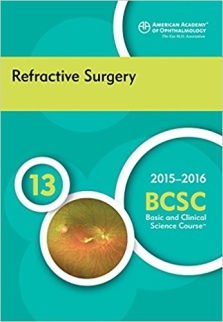
2015-2016 Basic and Clinical Science Course, Section 13: Refractive Surgery
Covers the science of refractive surgery, accommodative and nonaccommodative treatment of presbyopia, and patient evaluation.
Examines specific procedures in refractive surgery and their potential complications, and refractive surgery in ocular and
systemic disease. Includes information on lens implants used in the United States and other countries.
Upon completion of Section 13, readers should be able to:
* Identify the general types of lasers used in refractive surgeries
* Explain the steps including medical and social history, ocular examination and ancillary testing in evaluating whether a
patient is an appropriate candidate for refractive surgery
* For incisional keratorefractive surgery, describe the history, patient selection, surgical techniques, outcomes, and
complications
* Explain recent developments in the application of wavefront technology to surface ablation and LASIK
* Describe the different types of IOLs used for refractive correction
Section chair: M. Bowes Hamill, MD
About the BCSC
The Academy's Basic and Clinical Science Course (BCSC) is ophthalmology's definitive compilation of scientific research and
clinical experience. It is continually updated by a faculty of more than 80 expert ophthalmologists. Each of the 13 volumes
includes fundamental clinical knowledge; numerous tables, photos and illustrations; self-assessment questions with answers;
and opportunities for earning AMA PRA Category 1 Credit(TM).
Beginning with the 2013-2014 edition, the Academy and the European Board of Ophthalmology (EBO) have partnered to make the
BCSC the standard text for all European ophthalmology training programs. The EBO now recommends the BCSC as the primary
educational resource for European trainees and ophthalmologists studying for the annual EBO Diploma Exam.


